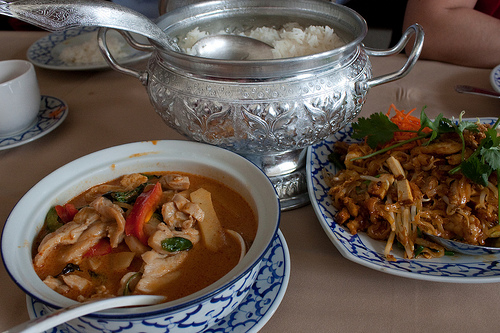The cuisine of Thailand is a complex culmination of many different ingredients, techniques, and influences. An analysis of the history of the Thai people, including their food and culture, is necessary to understand modern Thai cuisine. In this analysis, it is evident that there have traditionally been two types of Thai cuisine, Royal Thai cuisine and home Thai cooking. Upon a deeper examination of home Thai cooking, there is a complexity created from the cuisine variations in the different areas of Thailand. The variations, in regard to culinary art, are centered on the north, northeast, central plains, and south. Royal Thai cuisine, also known as palace cooking, is very different from home Thai cooking. Royal Thai cuisine is comparable to the haute cuisine found in French culinary art. Palace cooking is focused on visual appeal. Sophistication is presented in every aspect of palace meals, from subtly of flavor to memorable dishes garnished with elaborate food carvings. Thai cuisine is rich in history. The history has served as a base for modern Thai cuisine. Modern Thai cuisine is a complex art exemplified through the differences in the culinary arts of Thailand. Home Thai cooking is a flavorful cuisine, with simplistic preparation and presentation, differing by region. In contrast, Royal Thai cuisine demonstrates the lavish and sophisticated extremes of Thai cuisine.
Sukhothai was the first independent Thai kingdom. This kingdom was founded in the early thirteenth century. A stone tablet from this kingdom has been found and is credited to King Ramkhamhaeng. King Ramkhamhaeng’s tablet bears the inscription “In the water there are fish, in the fields there is rice.”[1] This statement shows two important ingredients that have been a part of the Thai diet into the modern age, fish and rice. The abundance of fish can be found in the waterways and the 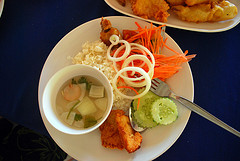 sea. Rice first appeared with the earliest settlers. This was long before the Thai people were present. However, the Thai people can be credited with the creation of a vastly complicated set of paddy fields used for cultivation. Other ingredients became available over the centuries from a wide range of other cultures. Some of these cultures included China, India, Persia, and Portugal. Even the chili, which is considered an essential ingredient of Thai cuisine, was introduced from South America. Regardless of the origin of ingredients, they have been modified and refined into a distinctive Thai cuisine.[2]
sea. Rice first appeared with the earliest settlers. This was long before the Thai people were present. However, the Thai people can be credited with the creation of a vastly complicated set of paddy fields used for cultivation. Other ingredients became available over the centuries from a wide range of other cultures. Some of these cultures included China, India, Persia, and Portugal. Even the chili, which is considered an essential ingredient of Thai cuisine, was introduced from South America. Regardless of the origin of ingredients, they have been modified and refined into a distinctive Thai cuisine.[2]
Preparing any food requires proper utensils for the task. In a traditional Thai kitchen there are certain utensils that are likely to be found. These utensils are: strainer, coconut grater, chopping block, cleaver, glutinous rice basket (kratip), mortar and pestle, stove, skewers, wok, spatula, coconut shell spoon, curry pot, and a steamer. These items were originally introduced by Thai ancestors who migrated from China. A Thai strainer is about twelve inches long. It has a bamboo handle attached to a round metal basket. The strainer is typically used for straining liquids and grease from many foods. The coconut grater consists of a wooden handle with a metal cutting tool at the end. Coconut is used extensively in Thai cuisine, making this utensil invaluable. The wooden chopping block is a wooden cutting board that is about one inch thick. In the Thai kitchen it is mainly used for cutting meats and fish. The cleaver is the main cutting tool in a Thai kitchen. A cleaver is used to chop, slice, and dice a wide array of meats, fish, vegetables, and herbs that are used in Thai cooking. The glutinous rice basket is another necessity in Thai cooking. The glutinous rice basket is made of tightly woven bamboo and is used to keep sticky rice warm and moist. The mortar and pestle is earthenware crafted of stone or wood. The mortar has a deep weighted base and the pestle is reminiscent of a small club. This utensil is used to make curry paste or to bruise other flavorings found in Thai food. A Thai stove, heated by charcoal, is a simple clay structure with an insert on the top to hold a wok or a pot. The stove looks very similar to a clay planting pot. Skewers are also important utensils. Skewers are commonly made of bamboo. They are used to skewer meats. This is similar to kebob-style found in the Mediterranean culture. A wok is an extremely versatile utensil. The uses for a wok range from stir-frying to deep-fat-frying. It is dome shaped and distributes heat much better than a conventional frying pan. The spatula, made from wood or metal, is the utensil commonly used with wok cooking. A coconut shell spoon is used for ladling and consists of a wooden handle attached to a coconut half-shell. The curry pot is a clay pot that has large handles making it easy to carry. As the name implies, it is used to hold the many curries that are popular in Thai cuisine. The single most important utensil in the Thai kitchen is a steamer. Thai people eat rice with every meal and a steamer is essential in making that possible. The steamer is usually made from clay or aluminum and fits on top of the charcoal stove. All of these utensils are considered necessities, rather than luxuries, in the Thai kitchen. They are the basic tools used for the preparation of the most commonly used ingredients in Thai cuisine.[3]
The food of the Thai people is a complex counterbalancing of sweet, spicy, salty, sour, and bitter flavors experienced throughout a meal[4]. This flavor balance is 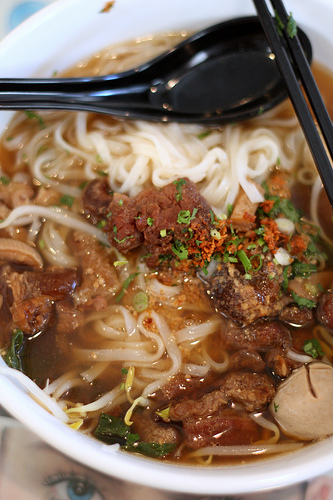 common throughout all of Thailand. However, the balance is achieved in many different ways according to region. Each culinary region of Thailand has its own cultural food influences, climate, terrain, ingredients, preparations, dishes, and food service practices.
common throughout all of Thailand. However, the balance is achieved in many different ways according to region. Each culinary region of Thailand has its own cultural food influences, climate, terrain, ingredients, preparations, dishes, and food service practices.
The climate of Thailand is considered to be a tropical climate. However, the north, northeast, and the central plains are described by a distinct three seasons while in the south only two seasons are easily identifiable. From northern to central Thailand, November to February is the cool season, March to June is the hot season, and June to November is the rainy season. In southern Thailand, April to October is the rainy season and November to March is the dry season.[5]
In the north of Thailand the land is mostly jungle-covered mountains and valleys. Northern Thai cuisine is mainly influenced by two sources. Those two influences are China and Myanmar (previously Burma). The Chinese influence is reflected in the widespread use of noodles and the Myanmar influence is reflected in the curries and chili dip styles of northern Thailand.[6] There are many ingredients that are commonly available in the north. Some of these ingredients are a result of the cold mountain areas. These areas produce strawberries, apples, and carrots. Naem, which is a pork sausage, is a distinctive ingredient of the north. Naem is eaten raw, with rice, or mixed into various dishes.[7] Food service is unique in the north. Most meals are eaten while sitting on straw mats and food is gathered from a kantoke. A kantoke is a small table made of oak which looks like a tray with legs. On the table, a selection of entrees are offered including curries, sticky rice, various par-boiled vegetables, deep-fried fish, and a choice of chili paste dips (nam phrik).[8]
The northeast area of Thailand, also known as Isan, is a high plateau with low rainfall and porous soil. The most influential culture on northeastern Thai cuisine comes from the neighboring country of Laos. This is evidenced with glutinous rice being a staple food, which is consumed both as a base for meals and as desserts. The kratip is a local icon in the northeast. Laotian herbs, such as dill, are widely used in this area of Thailand. It is not common to use dried herbs and spices in the northeast. However, many condiments, such as fish sauce, are extensively used.[9] In the northeast, spiciness is a requirement of most foods. Many ingredients are commonly used. Some of these ingredients include chilies, tamarind, fish, and sausage. In fact, freshwater fish and shrimp are the main sources of protein. Even though freshwater fish and shrimp are the main sources of protein, northeasterners have a reputation for eating anything for protein including frogs, birds, snakes, and insects[10]. A number of popular Thai dishes originate in the northeast. One such dish is called som tam. Som Tam is a spicy raw papaya salad mixed with chilies, garlic, tomatoes, green beans, lime juice, and fish sauce. Another popular dish is named larb. Larb is a sour minced beef, chicken, or pork salad. Curries without the use of coconut milk are popular in the northeast region.[11] The cuisine of the northeast is rather simple and is traditionally eaten on a pa kao table made from bamboo or rattan[12].
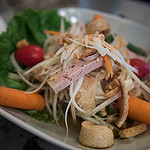 The central plains region is considered the economic and cultural center of Thailand. Due to the Chao Phraya River, this area is the most fertile and supplies many fresh water fish. The fertility of this region allows many crops to be grown. Rice is the main agricultural product; however, a variety of fruits, vegetables, and flowers are grown. The many fruits that are commonly grown include mango, durian, custard apple, pomelos, and guavas. Unlike the north and northeast regions, plain jasmine rice is preferable to the central plains people. Rice is usually prepared steamed, but sometimes boiled or fried.[13] The vast availability of fresh ingredients contributes to the cuisine found in the central pains. Nam Phrik is a typical dish that is usually served with fresh seasonal vegetables such as cucumber, morning glory stalks, makok leaves, cha-om, and gratin. Nam Phrik is not only served with vegetables, but used in a variety of other dishes. Spicy Thai salads (yam) mixed with lemongrass, kaffir lime leaves, and herbs are an example. Desserts are popular in the central plains region. There are many traditional desserts made using many different techniques. Most desserts share three main ingredients: flour, coconut, and sugar. Fruits are commonly used in preparing desserts. For example, the addition of fruit to a light clear syrup and crushed ice is a popular dessert. In this region of Thailand, most dishes are simplistic and rely mostly on the ingredients for acclaim.[14]
The central plains region is considered the economic and cultural center of Thailand. Due to the Chao Phraya River, this area is the most fertile and supplies many fresh water fish. The fertility of this region allows many crops to be grown. Rice is the main agricultural product; however, a variety of fruits, vegetables, and flowers are grown. The many fruits that are commonly grown include mango, durian, custard apple, pomelos, and guavas. Unlike the north and northeast regions, plain jasmine rice is preferable to the central plains people. Rice is usually prepared steamed, but sometimes boiled or fried.[13] The vast availability of fresh ingredients contributes to the cuisine found in the central pains. Nam Phrik is a typical dish that is usually served with fresh seasonal vegetables such as cucumber, morning glory stalks, makok leaves, cha-om, and gratin. Nam Phrik is not only served with vegetables, but used in a variety of other dishes. Spicy Thai salads (yam) mixed with lemongrass, kaffir lime leaves, and herbs are an example. Desserts are popular in the central plains region. There are many traditional desserts made using many different techniques. Most desserts share three main ingredients: flour, coconut, and sugar. Fruits are commonly used in preparing desserts. For example, the addition of fruit to a light clear syrup and crushed ice is a popular dessert. In this region of Thailand, most dishes are simplistic and rely mostly on the ingredients for acclaim.[14]
The southern part of Thailand is a long peninsula covered with flourishing jungle. Along the center of the southern region are rugged limestone mountains. The coast consists of beaches and fishing ports. This region has the Gulf of Thailand and the Indian Ocean located on opposite sides of the peninsula. The south has enormous plantations of pineapple, coconut, and rubber. Due to the large Muslim influence along the Malaysian boarder a unique culture is formed in this region.[15] Southern Thailand’s connection with the Muslim country of Malaysia lends an Islamic cultural aspect to their food. There is a wide use of turmeric, which gives southern food a yellowish color. This can be evidenced in dishes such as gaeng lueng (spicy coconut shoot soup), khao mok gai (turmeric rice topped with chicken), and gaeng som (tamarind flavored soup). The curries of the south have an Indian influence. One such curry is named massaman. Massaman is made from the same ingredients that may be found in other regions of Thailand, but it incorporates cardamom, cloves, and cinnamon which are common to India. This type of curry, as well as many dishes from the south, is commonly presented with peanuts.[16] Indonesia has influenced southern dishes. An example is satay which is commonly eaten with a spicy peanut sauce. Also, the large Chinese community has a great influence in the south. In fact, the Chinese community holds a vegetarian festival in Phuket every year. 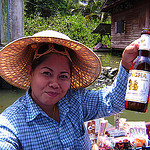 Common ingredients in southern cooking are characterized by local produce. Many dishes use coconut as a main ingredient; coconut milk is used to cool the chilies in curries and soups, coconut flesh is grated and served as a condiment, and coconut oil is used for frying.[17] Since this region is practically surrounded by water, southerners enjoy an abundant supply of seafood. Many dishes are adorned with seafood such as rock lobster, fish, crabs, prawns, squids, clams and mussels. Some of the most famous dishes using seafood are goong ga-thi nor mai sod (prawns and bamboo shoots in coconut soup), poo pad pong gari (fried crab with yellow curry), and goong pad sataw (fried prawns with twisted cluster beans).[18]
Common ingredients in southern cooking are characterized by local produce. Many dishes use coconut as a main ingredient; coconut milk is used to cool the chilies in curries and soups, coconut flesh is grated and served as a condiment, and coconut oil is used for frying.[17] Since this region is practically surrounded by water, southerners enjoy an abundant supply of seafood. Many dishes are adorned with seafood such as rock lobster, fish, crabs, prawns, squids, clams and mussels. Some of the most famous dishes using seafood are goong ga-thi nor mai sod (prawns and bamboo shoots in coconut soup), poo pad pong gari (fried crab with yellow curry), and goong pad sataw (fried prawns with twisted cluster beans).[18]
Royal Thai cuisine and home Thai cooking have one basic difference. The one basic difference is sophistication. Royal cuisine is a more sophisticated version of regional cuisine. Royal cuisine was influenced by the kitchens of the Royal Court, where the dishes were elaborately prepared. This meticulous meal making was considered an art form and the creation of culinary masterpiece. In essence, Royal Thai cuisine focuses on appearance as much as flavor.[19]
Royal Thai cuisine refers to the food preparation that originated in the Grand Palace located in Bangkok, Thailand. This mile-square area was where the women of the court lived. It was a complete town in itself. It had a tight network of housing with narrow streets, gardens, lawns, artificial lakes, and shops. It had its own government, institutions, laws, and courts. At the height of the Grand Palace, during the reign of King Rama V, the population included nearly three thousand women. Of the three thousand women, a few were ranked as Queen, but the majorities were ladies-in-waiting and lower attendants. The inner palace was where these women 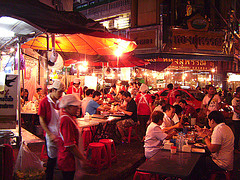 were taught the most refined aristocratic skills. These skills were expected to be perfected and passed on. The royal women were taught how to prepare various foods. The foods that they were taught to prepare were more subtle in flavor than their outside versions and highly memorable in visual appeal. The most visible palace skill was the art of fruit and vegetable carving. These carvings were mainly used as garnishes. Some of these carvings were so intricate that they took as long to create as the dishes they were garnishing. The characteristics of palace cooking consisted of meticulous hours of preparation and a highly refined presentation style. One example is foi thong, which is a blend of egg yolks and sugar transformed into a nest of golden threads. Another example is look choop, which are tiny imitation fruits shaped by hand from a mixture of sweet bean paste and coconut milk to exactly match their real-life counterparts. Under the rule of King Rama VI, royal polygamy came to an end. After this change, the ladies of the Grand Palace slowly left the exclusive community. However, palace cooking continued to survive through the descendants of these royal women.[20]
were taught the most refined aristocratic skills. These skills were expected to be perfected and passed on. The royal women were taught how to prepare various foods. The foods that they were taught to prepare were more subtle in flavor than their outside versions and highly memorable in visual appeal. The most visible palace skill was the art of fruit and vegetable carving. These carvings were mainly used as garnishes. Some of these carvings were so intricate that they took as long to create as the dishes they were garnishing. The characteristics of palace cooking consisted of meticulous hours of preparation and a highly refined presentation style. One example is foi thong, which is a blend of egg yolks and sugar transformed into a nest of golden threads. Another example is look choop, which are tiny imitation fruits shaped by hand from a mixture of sweet bean paste and coconut milk to exactly match their real-life counterparts. Under the rule of King Rama VI, royal polygamy came to an end. After this change, the ladies of the Grand Palace slowly left the exclusive community. However, palace cooking continued to survive through the descendants of these royal women.[20]
Thai cuisine is rich in history. The history has served as a base for modern Thai cuisine. Modern Thai cuisine is a complex art. This is exemplified through the differences in the culinary arts of Thailand. Home Thai cooking is a flavorful cuisine, with simplistic preparation and presentation, differing by region. In contrast, Royal Thai cuisine demonstrates the lavish and sophisticated extremes of Thai cuisine. The first Thai kingdom of the early thirteenth century is an important starting point for Thai cuisine. During that period, rice and fish became an extremely important food source. Rice was present before the Thai people, used by the earliest settlers. 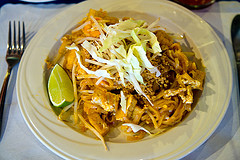 However, Thai people can be credited for the innovation of a complicated set of paddy fields. These paddy fields enhanced rice cultivation and increased availability. Over the centuries the cultures of China, India, Persia, South America, and Portugal contributed ingredients that have been refined. These refined ingredients are now essential to Thai cuisine. In creating Thai cuisine, the Thai kitchen is an integral component. The Thai kitchen contains utensils that make it possible to properly prepare common Thai ingredients. Home Thai cooking varies according to several characteristics including outside cultural influences, climate, terrain, ingredients, preparations, dishes, and food service. Different variations of these characteristics can be found in the northern, northeastern, central plains, and southern regions of Thailand. Royal Thai cooking was prepared by the royal women of the Grand Palace in Bangkok. Palace cooking was different from home Thai cooking in sophistication. The difference in sophistication is in two main categories, flavor and presentation. The flavor of palace cuisine was often more subtle in flavor than their regional counterparts. Presentation was a very important part of palace cooking. The art of fruit and vegetable carving was employed to create a highly visual and memorable dining experience. Thai cooking has certainly evolved into a complex cuisine with many variations in flavors, ingredients, techniques, and sophistication.
However, Thai people can be credited for the innovation of a complicated set of paddy fields. These paddy fields enhanced rice cultivation and increased availability. Over the centuries the cultures of China, India, Persia, South America, and Portugal contributed ingredients that have been refined. These refined ingredients are now essential to Thai cuisine. In creating Thai cuisine, the Thai kitchen is an integral component. The Thai kitchen contains utensils that make it possible to properly prepare common Thai ingredients. Home Thai cooking varies according to several characteristics including outside cultural influences, climate, terrain, ingredients, preparations, dishes, and food service. Different variations of these characteristics can be found in the northern, northeastern, central plains, and southern regions of Thailand. Royal Thai cooking was prepared by the royal women of the Grand Palace in Bangkok. Palace cooking was different from home Thai cooking in sophistication. The difference in sophistication is in two main categories, flavor and presentation. The flavor of palace cuisine was often more subtle in flavor than their regional counterparts. Presentation was a very important part of palace cooking. The art of fruit and vegetable carving was employed to create a highly visual and memorable dining experience. Thai cooking has certainly evolved into a complex cuisine with many variations in flavors, ingredients, techniques, and sophistication.
Bibliography
Kong Foong Ling, The Food of Asia (Boston: Periplus Editions, 1998).
“Thai Food Tonight,” Dim Geefay, http://www.thaifoodtonight.com/utensils.htm (accessed October 28, 2007).
Corinne Trang, Essentials of Asian Cuisine Fundamentals and Favorite Recipes (New York: Simon & Schuster, 2003).
“Thailand – Land of Smiles,” Horizon Thai Boxing Camp Ltd, http://www.horizonmuaythai.com/Thailand/weather.html (accessed October 20, 2007).
“Thailand Regional Food,” ThailandParadise.com, http://www.thailandparadise.com/thailand-regional-food.htm (accessed October 19, 2007).
“Thailand’s Regional Cuisines,” Temple of Thai, http://www.templeofthai.com/cooking/thai-cuisine.php (accessed October 19, 2007).
“Regional Thai Cooking,” Amari Hotels, Resorts and Spas, http://www.amari.com/tta/cooking_regional.asp (accessed October 19, 2007).
“Thai Food & Cooking,” ThaiFocus.com, http://www.thaifocus.com/thaifood.htm (October 20, 2007).
[1] Ling, The Food of Asia, 123.
[2] Ibid, 124.
[3] “Thai Food Tonight,” http://www.thaifoodtonight.com/thaifoodtonight/utensils.htm.
[4] Trang, Essential of Asian Cuisine Fundamentals and Favorite Recipes, 58.
[5] “Thailand – Land of Smiles,” http://www.horizonmuaythai.com/Thailand/weather.html.
[6] “Thailand Regional Food,” http://www.thailandparadise.com/thailand-regional-food.htm.
[7] “Thailand’s Regional Cuisines,” http://www.templeofthai.com/cooking/thai-cuisine.php.
[8] “Thailand Regional Food,” http://www.thailandparadise.com/thailand-regional-food.htm.
[9] “Regional Thai Cooking,” http://www.amari.com/tta/cooking_regional.asp.
[10] “Thailand’s Regional Cuisines,” http://www.templeofthai.com/cooking/thai-cuisine.php.
[11] “Thailand Regional Food,” http://www.thailandparadise.com/thailand-regional-food.htm.
[12] “Thailand’s Regional Cuisines,” http://www.templeofthai.com/cooking/thai-cuisine.php.
[13] “Regional Thai Cooking,” http://www.amari.com/tta/cooking_regional.asp.
[14] “Thailand Regional Food,” http://www.thailandparadise.com/thailand-regional-food.htm.
[15] “Regional Thai Cooking,” http://www.amari.com/tta/cooking_regional.asp.
[16] “Thailand Regional Food,” http://www.thailandparadise.com/thailand-regional-food.htm.
[17] “Regional Thai Cooking,” http://www.amari.com/tta/cooking_regional.asp.
[18] “Thailand Regional Food,” http://www.thailandparadise.com/thailand-regional-food.htm.
[19] “Thai Food & Cooking,” http://www.thaifocus.com/thaifood.htm.
[20] Ling, The Food of Asia, 126.
Photo by Andreas Lehner 2014 
Photo by Andreas Lehner 2014 
Photo by hans s 
Photo by pointnshoot 
Photo by Edsel L 
Photo by boo_licious 
Photo by mynameisharsha 

